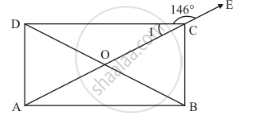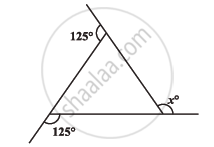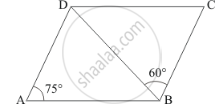Advertisements
Advertisements
प्रश्न
In the given figure, ABCD is a rectangle in which diagonal AC is produced to E. If ∠ECD = 146°, find ∠AOB.
उत्तर
ABCD is a rectangle
With diagonal AC produced to point E.

We have
∠1 + ∠DCE = 180° (Linear pair)
∠1 + 146° = 180°
∠1 = 34°
We know that the diagonals of a parallelogram bisect each other.
Thus OC = OD
Also, angles opposite to equal sides are equal.
Therefore,
∠ODC = 34°
By angle sum property of a traingle
∠ODC +∠1 + COD = 180°
34° + 34° CPD = 180°
68° +∠COD = 180°
∠COD = 112°
Also, ∠CODand ∠AOB are vertically opposite angles.
Therefore, ∠AOB = 112°
Hence, the required measure for ∠AOBis 112°.
APPEARS IN
संबंधित प्रश्न
Find x in the following figure:

In a quadrilateral ABCD, the angles A, B, C and D are in the ratio 1 : 2 : 4 : 5. Find the measure of each angles of the quadrilateral
In a quadrilateral ABCD, CO and DO are the bisectors of `∠`C and ∠D respectively. Prove that
`∠`COD = `1/2` (`∠`A+ `∠`B).
In Fig. below, ABCD is a parallelogram in which ∠DAB = 75° and ∠DBC = 60°. Compute
∠CDB and ∠ADB.

The figure formed by joining the mid-points of the adjacent sides of a square is a
If the degree measures of the angles of quadrilateral are 4x, 7x, 9x and 10x, what is the sum of the measures of the smallest angle and largest angle?
Can the angles 110º, 80º, 70º and 95º be the angles of a quadrilateral? Why or why not?
If three angles of a quadrilateral are each equal to 75°, the fourth angle is ______.
The angles of a quadrilateral are in the ratio 1 : 2 : 3 : 4. The smallest angle is ______.
In a quadrilateral PQRS, ∠P = 50°, ∠Q = 50°, ∠R = 60°. Find ∠S. Is this quadrilateral convex or concave?
